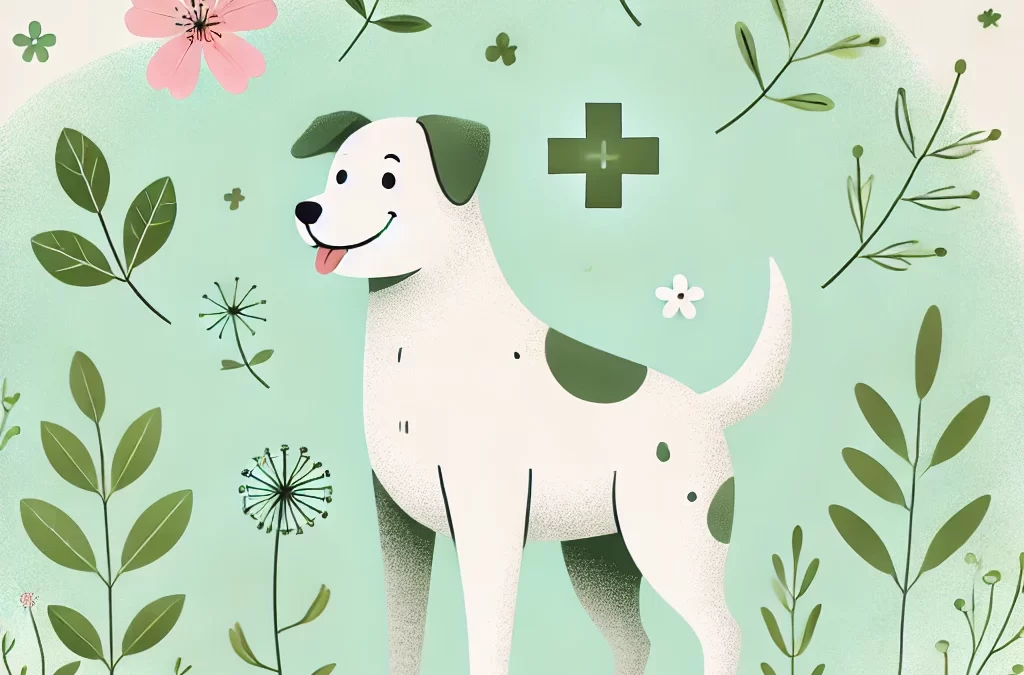
執筆者 TCMVET | 2024年12月8日 | 犬の癌と腫瘍
tmentオプション
犬は、身だしなみを整えるため、または不快感を和らげるため、本能的に体を舐めることがよくあります。しかし、犬が腫瘍などの特定の場所を執拗に舐める場合は、注意が必要な根本的な問題を示している可能性があります。この記事では、犬が腫瘍を舐める理由、潜在的なリスク、およびこの問題に対処する効果的な方法について説明します。
犬はなぜ腫瘍を舐めるのでしょうか?
犬にとって舐めることは自然な行動ですが、腫瘍を執拗に舐める場合は、いくつかの根本的な理由が考えられます。
- 不快感または痛み
腫瘍、特に炎症を起こしたり潰瘍ができたりしたものは、刺激を引き起こす可能性があります。犬は、この不快感を和らげるために舐めることがよくあります。
- 感染または分泌物
腫瘍によっては、血液、膿、その他の体液が出ることがありますが、犬は本能的に舐めてそれをきれいにしようとします。
- 好奇心
犬は触覚と感覚に敏感な生き物です。腫瘍やしこりがあると、犬は異常に感じて舐めて調べようとすることがあります。
- 不安やストレス
感情的なストレスは舐める行動として現れることがあります。犬は、自己鎮静メカニズムとして、不快な部分に集中することがあります。
腫瘍を舐めるリスク
舐めることは無害に思えるかもしれませんが、合併症を引き起こす可能性があります。
- Infection舐めることで細菌が入り込み、二次感染を引き起こす可能性があります。
- 潰瘍: 舐め続けると腫瘍の上の皮膚が傷つき、さらなる炎症や出血を引き起こす可能性があります。
- 治癒の遅れ: 腫瘍が治療または除去された場合、舐めると治癒プロセスが妨げられる可能性があります。
- 悪性細胞の拡散: まれに、舐めることによる刺激が癌細胞の拡散を悪化させる場合があります。
舐めるのを防ぐ方法
さらなる合併症を避けるためには、犬が腫瘍を舐めないようにすぐに行動を起こすことが重要です。
- 獣医に相談する
獣医師は腫瘍を検査して良性か悪性かを判断し、適切な治療方針を勧める必要があります。
- 保護具を使用する
犬が腫瘍に近づかないように、エリザベスカラー、膨張式カラー、またはボディスーツの使用を検討してください。
- 根本原因に対処する
診断に応じて、不快感を軽減し腫瘍に対処するために、手術、投薬、またはその両方の組み合わせによる治療が行われる場合があります。
- 衛生を保つ
患部を清潔に保ち、獣医の指示に従うことで、感染を防ぎ、炎症を軽減することができます。
愛犬の回復を自然にサポート
従来の治療法に加えて、自然療法は犬の健康をさらにサポートすることができます。 TCMVET 白頭霄伝統的な中国医学に基づいて、腫瘍の成長を抑制し、免疫機能をサポートするように特別に処方されています。
ペットの飼い主は、TCMVET Baituxiao を使用したことでペットのエネルギーと快適さが向上したと肯定的な感想を述べています。これは総合的なケア プランに追加するのに最適ですが、新しいサプリメントを導入する前には必ず獣医師に相談してください。
愛犬の健康を守る
愛犬が腫瘍を舐めている場合は、何かがおかしいという明らかな兆候です。その行動に対処するための措置を講じ、専門家の指導を求めることで、ペットの健康に大きな違いが生まれます。獣医によるケアと TCMVET Baituxiao などの天然サプリメントを組み合わせることで、愛犬の生活の質が向上し、回復中に最大限のサポートを提供できます。
注意深く積極的に行動することで、犬がどんな困難に直面しても、犬が快適に過ごし、世話をされている状態を保つことができます。

執筆者 TCMVET | 2024年12月8日 | 犬の癌と腫瘍
がんは、犬の飼い主が直面する最も困難な健康問題の一つです。犬のがんの症状は、老化の兆候や軽い病気と間違われることが多く、病気が進行するまで気付かれないことがよくあります。この記事では、犬のがんの症状を理解するための新しいアプローチを採用し、自然療法がペットの健康をサポートする上でどのような役割を果たすことができるかを探ります。
犬の癌の一般的な症状
がんを早期に発見すると、治療結果に大きな違いが生まれます。注意すべき一般的な兆候は次のとおりです。
- しこりや腫れ首、脚、腹部などの部位に持続的なしこりや異常な腫れがある場合は、決して無視しないでください。
- Changes in Appetite突然食べ物への興味がなくなったり、食べるのが困難になったりする場合は、根本的な健康上の問題が示唆されることがあります。
- Unexplained Weight Loss食事や活動を調整せずに体重が大幅に変化した場合は、がんの兆候である可能性があります。
- 行動の変化無気力の増加、運動への嫌悪、または不快感の兆候は、内部の健康問題を示している可能性があります。
- 異常放電: 持続的な鼻水、便に血が混じっている、または異常な臭いがする場合は警告サインである可能性があります。
- 治癒しない傷: 傷や痛みが適切な時間内に治らない場合は、より深刻な問題がある可能性があります。
がん治療における自然療法の役割
手術、化学療法、放射線療法などの従来の治療は多くの場合必要ですが、費用がかかり、副作用を伴うこともあります。そこで、補完的なアプローチとして自然療法が役立ちます。ハーブやサプリメントを慎重に選択すれば、ペットの生活の質を高め、回復をサポートすることができます。
そのような天然サプリメントの一つは TCMVET 白頭霄は、伝統的な中国医学にヒントを得た処方です。腫瘍の成長を抑え、体全体のバランスを促進することで犬をサポートするように設計されています。ペットの飼い主は、獣医によるケアと併せてこの製品を使用すると、犬のエネルギーレベルと健康状態が改善したと報告しています。
あなたの愛犬の旅をサポートする
愛犬が上記の症状のいずれかを示している場合は、すぐに獣医に相談して、徹底的な診断を受けてください。早期発見と総合的な治療アプローチを組み合わせることで、ペットの人生に大きな違いが生まれます。
TCMVET Baituxiao のような自然療法を犬のケア ルーチンに取り入れることは、従来の治療法を補完するだけでなく、犬の全体的な健康をさらにサポートすることにもなります。情報を入手し、積極的に行動することで、愛犬が可能な限り最高のケアを受けられるようにすることができます。

執筆者 TCMVET | 2024年12月7日 | 犬の癌と腫瘍
移行上皮癌 (TCC) は、犬の膀胱癌の中で最も一般的なタイプであり、ペットとその飼い主の両方にとって大きな問題となることがよくあります。その悪性度にもかかわらず、早期発見と積極的な治療アプローチは、犬の生活の質を向上させるのに役立ちます。
移行上皮癌とは何ですか?
TCC は、通常、膀胱の上皮層、特に尿道と尿管が交わる膀胱三角部に発生する悪性癌です。主に膀胱に影響を及ぼしますが、治療せずに放置すると、尿道、前立腺、リンパ節、その他の臓器に転移する可能性があります。
どの犬が危険にさらされているのでしょうか?
TCC はどの犬にも発生する可能性がありますが、次のような特定の犬種は発症しやすい傾向があります。
- スコティッシュ・テリア(最もリスクが高い)
- シェットランド・シープドッグ
- ウエストハイランドホワイトテリア
- ビーグル
TCC はメスの犬や高齢の犬に発生する可能性が高くなりますが、この症状はこれらのグループに限ったものではありません。
注意すべき症状
TCC の初期症状は一般的な尿路感染症に似ているため、診断が困難です。主な症状は次のとおりです。
- 排尿困難(排尿困難)
- 排尿回数の増加(頻尿)
- 尿に血が混じる(血尿)
- 尿失禁
- 排尿困難または排尿障害
病気が進行すると、無気力、体重減少、腹痛などの症状が現れることがあります。
TCC はどのように診断されますか?
TCC の診断には、他の病状を除外し、癌の存在を確認するためのさまざまな検査を組み合わせる必要があります。
- 尿検査: 血液、細菌、異常細胞の検出に役立ちます。
- イメージング: 超音波検査やX線検査で膀胱の腫瘤が発見されることがあります。
- Cystoscopy: 生検採取のための膀胱の直接視覚化。
- BRAF変異検査TCC に関連する変異を検出する非侵襲的な尿検査。
効果的な治療計画を実行するには、早期かつ正確な診断が重要です。
治療の選択肢
TCC が治癒することはほとんど不可能ですが、さまざまな治療法で病気を管理し、犬の生活の質を向上させることができます。
- 医薬品:
- ピロキシカムなどの非ステロイド性抗炎症薬(NSAID)は、抗がん作用があるため処方されることが多いです。
- ミトキサントロンやビンブラスチンなどの化学療法剤は、単独で、または NSAID と組み合わせて使用されることがあります。
- 手術:
- 腫瘍が限局している場合は外科的切除が選択肢となりますが、腫瘍が三角部にある場合は手術が困難な場合が多くあります。
- 放射線治療:
- 手術が不可能な場合に腫瘍を縮小し、症状を緩和するのに役立ちます。
- 緩和ケア:
- 痛みの管理と排尿障害の対処を通じて快適さを維持することに重点を置いています。
TCC とともに生きる: 飼い主が知っておくべきこと
TCC に罹患した犬の管理には、定期的な獣医による検査と症状の監視が必要です。ペットの飼い主向けのヒントをいくつか紹介します。
- 食事と水分補給: 尿の健康をサポートするために、バランスの取れた食事を与え、犬の水分補給をしっかり行ってください。
- 医薬品処方された薬を継続的に投与し、副作用があれば獣医に報告してください。
- 観察排尿パターンの変化や不快感の兆候に注意してください。
- 心の支えTCC はペットと飼い主の両方にストレスを与える可能性があるため、獣医師またはペット コミュニティからサポートを求めてください。
予後
TCC に罹患した犬の予後は、病気の進行段階と治療計画によって異なります。適切なケアを行えば、多くの犬は診断後数か月、あるいは 1 年以上快適に生活できます。早期発見と積極的なアプローチは、犬の寿命を延ばし、生活の質を維持する上で大きな違いを生む可能性があります。
最終的な考え
移行上皮癌は深刻な診断ですが、獣医学の進歩により、ペットの飼い主に希望と選択肢がもたらされています。この病気を理解し、獣医師と緊密に協力することで、愛犬が可能な限り最善のケアを受けられるようになります。

執筆者 TCMVET | 2024年12月7日 | 犬の癌と腫瘍
犬の腹部に大きな腫瘍が見つかった場合、飼い主は誰でも不安に思うでしょう。心配するのは当然ですが、考えられる原因、症状、治療の選択肢を理解することで、犬の健康について十分な情報に基づいた判断を下すことができます。
腹部腫瘤とは何ですか?
腹部腫瘤は、肝臓、脾臓、腸などの臓器、または周囲の組織から発生する可能性のある、胃の領域における異常な増殖です。これらの腫瘤は大きさがかなり異なり、良性(非癌性)または悪性(癌性)の場合があります。
腹部腫瘤の一般的な原因
- 良性腫瘍
- 脂肪腫: 一般的に無害な脂肪腫瘍。
- 嚢胞: 時間の経過とともに大きくなる可能性があるが、通常は危険ではない、液体で満たされた袋。
- 悪性腫瘍
- 血管肉腫:脾臓に発生する一般的な癌。
- リンパ腫:リンパ節に影響を及ぼし、腹部に転移する可能性があります。
- 癌腫:内臓の上皮組織から発生する腫瘍。
- その他の原因
- 膿瘍: 膿がたまったポケットにつながる感染症。
- 臓器肥大: 肝臓病などの病気は、臓器の肥大に似た症状を引き起こすことがあります。
注意すべき症状
早期発見は結果に大きな影響を与える可能性があります。次の点に注意してください。
- 腹部の腫れまたは膨張
- 体重減少または食欲減退
- 嘔吐または下痢
- 無気力または不快感の兆候
- 腹部の圧迫による呼吸困難
診断
腹部腫瘤の診断には獣医師の専門知識が必要です。手順には以下が含まれます。
- 身体検査: 腹部を触診して異常な腫瘍を検出する
- 画像検査: 超音波またはX線検査により腫瘍の大きさ、位置、性質を判定する
- 生検または穿刺吸引: 分析のための組織サンプルの収集
- Blood Tests: 関連する健康状態の確認
治療の選択肢
治療法は腫瘍の種類と場所によって異なります。
- 外科的除去: 手術可能な集団にとっての第一線となることが多い
- 化学療法または放射線療法: 悪性腫瘍、特に手術が不可能な場合に使用される
- 緩和ケア: 症状が治療できない場合は、快適さを維持することに重点を置きます
ペットの飼い主のための積極的な対策
- 定期検診: 定期的な獣医の診察は問題を早期に発見するのに役立ちます
- 症状を監視する: 犬の行動や食欲の変化に注意してください
- 適切な栄養: バランスの取れた食事は全体的な健康と回復をサポートします
- セカンドオピニオン: 複雑なケースについては、ためらわずに他の獣医に相談してください
犬の腹部の大きな腫瘤は深刻な問題ですが、適切なタイミングで獣医の診察と適切な管理を受ければ、多くの犬は良い結果を得ることができます。常に獣医と緊密に協力し、愛犬にとって最善の治療法を決定してください。

執筆者 TCMVET | 2024年12月6日 | 犬の癌と腫瘍
愛するペットが癌と診断された場合、それはどんな飼い主にとっても困難な旅となる可能性があります。適切な治療オプションとサプリメントを探すことは、ペットの快適さと生活の質を確保する上で非常に重要です。オンラインで入手できる無数のペット癌サプリメントの中には、 TCMVET 白頭霄 犬や猫の腫瘍の成長を管理し、阻止するために設計された、自然で効果的な選択肢として際立っています。
ペットケアにおけるがんサプリメントの役割を理解する
ペットの癌は、多くの場合、身体的な不快感、エネルギーレベルの低下、免疫力の低下を引き起こします。手術、化学療法、放射線療法などの従来の治療法は効果的ですが、多くの場合、高額な費用と潜在的な副作用を伴います。ここで、天然サプリメントが次のような目的で補助的な役割を果たします。
- 免疫システムを強化します。
- 腫瘍の成長が遅い。
- 全体的な健康とエネルギーレベルを向上させます。
- 炎症や不快感を軽減します。
伝統的な治療法と科学的に裏付けられたサプリメントを組み合わせることで、ペットに、より健康で快適な生活を送る最高のチャンスを与えることができます。
TCMVET Baituxiaoとは?
TCMVET 白頭霄 は、伝統的な中国医学 (TCM) の原理に基づいた特殊なハーブ配合です。ペット専用に開発されており、天然成分の力を活用して次の効果を発揮します。
- 腫瘍の成長を抑える: 独自のブレンドが異常な細胞の増殖をターゲットにし、腫瘍の成長を遅らせます。
- 全体的な健康をサポート: 免疫力を高める特性により、ペットの自然な防御力を強化します。
- 症状を緩和する: Baituxiao は炎症を軽減し、エネルギーを改善し、ペットが活動的で幸せに過ごせるようにします。
TCMVET Baituxiao を選ぶ理由
- 天然成分: Baituxiaoは合成添加物を含まず、ペットの体に優しいハーブ成分を使用しています。
- 獣医師承認済み多くの獣医師は、腫瘍のあるペットの総合的な治療計画の一環としてその使用を支持しています。
- 科学的に配合: TCMVET 白滴霄は、現代の研究と中医学の専門知識を組み合わせて、安全性と有効性を考慮して慎重に作られています。
TCMVET Baituxiaoの使い方
TCMVET Baituxiao の使用は簡単で便利です。経口投与することも、食べ物に混ぜて簡単に摂取することもできます。投与量はペットのサイズと特定の健康上のニーズに基づいて調整され、最適な結果が保証されます。ペットの日常生活に新しいサプリメントを導入する前に、必ず獣医師に相談してください。
TCMVET Baituxiaoをオンラインで購入する場所
TCMVET Baituxiaoは、次のようなプラットフォームを通じてオンラインで便利に購入できます。 アマゾン, ショッピファイ、または直接 TCMVET ウェブサイトAmazon 倉庫からの配送を含む迅速な配送オプションにより、ペットの健康改善への旅を迅速かつ手間をかけずに始めることができます。
ペットオーナーの声
TCMVET Baituxiao を使用したペットの飼い主からは、心温まる成功談がよく寄せられます。ペットのエネルギー レベルが著しく向上し、腫瘍のサイズが縮小し、生活の質が向上したと報告する飼い主が多くいます。
適切なペットの癌サプリメントを選ぶためのヒント
効果的ながんサプリメントをオンラインで探すときは、次の点を考慮してください。
- 安全性と成分: ペットに安全な天然成分を使用した製品を選びましょう。
- レビューと推奨事項: 他のペットの飼い主からのフィードバックを探します。
- 管理の容易さ: ペットに与えやすいサプリメントを選びましょう。
- 専門家による指導: サプリメントがペットの治療計画に合っているかどうか、獣医師に相談してください。
結論
ペットの癌診断を乗り越えるのは決して簡単ではありませんが、適切なツールやサプリメントがあれば、 TCMVET 白頭霄、ペットに快適さ、ケア、健康の改善を提供できます。効果的ながんサプリメントをオンラインで購入することで、ペットの健康管理に積極的に取り組むことができます。今すぐ TCMVET Baituxiao を試して、あなたのペットにどのような変化をもたらすかを確認してください。





